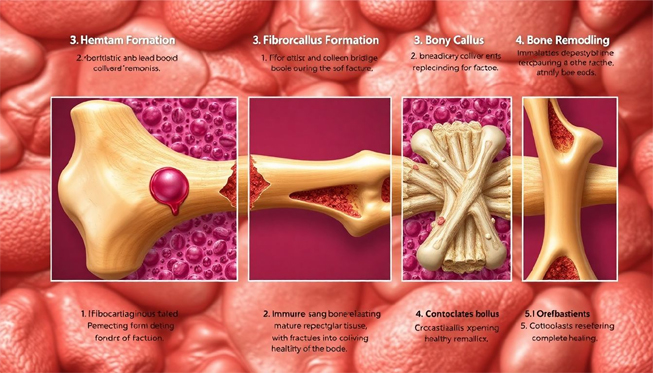What are the 5 stages of fracture healing?
A fracture is a break in the bone, often caused by injury or stress. Healing a fracture is a natural process that occurs in stages. Knowing the 5 stages of fracture healing helps patients and doctors ensure proper recovery.
The body repairs broken bones step by step. Each stage plays a key role in restoring strength and function. Proper care during these phases can speed up recovery and prevent complications.
Why Is Fracture Healing Important?
Fracture healing is crucial for regaining mobility and avoiding long-term issues. If a bone doesn’t heal correctly, it may lead to pain or deformity. Understanding the 5 stages of fracture healing ensures better treatment and faster recovery.
The 5 Stages of Fracture Healing
The 5 stages of fracture healing are:
- Hematoma Formation – Blood clots form at the break.
- Inflammation – Swelling and immune response begin.
- Soft Callus Formation – Cartilage and tissue bridge the gap.
- Hard Callus Formation – New bone starts to harden.
- Remodeling – Bone reshapes to its original strength.
Each stage must complete before moving to the next. Disruptions can delay healing.
How Understanding These Stages Helps Recovery
Recognizing the 5 stages of fracture healing helps in:
- Following the right treatment.
- Avoiding activities that slow healing.
- Ensuring bones heal correctly.
Doctors use this knowledge to guide recovery. Patients can follow medical advice better when they understand these stages.
Visual Guide to the 5 Stages of Fracture Healing
For a clearer understanding, refer to the table below:
| Stage | Key Process | Duration |
|---|---|---|
| Hematoma Formation | Blood clot forms at fracture site. | 1-2 days |
| Inflammation | Swelling and immune response occur. | Up to 1 week |
| Soft Callus Formation | Cartilage and tissue bridge the break. | 2-3 weeks |
| Hard Callus Formation | New bone hardens. | 4-8 weeks |
| Remodeling | Bone reshapes to original form. | Months to years |
By learning the 5 stages of fracture healing, patients can support their recovery effectively. Proper care at each stage leads to stronger, healthier bones.

Stage 1: Hematoma Formation – The First of the 5 Stages of Fracture Healing
What Happens Right After a Fracture?
When a bone breaks, the first of the 5 stages of fracture healing begins. Blood vessels around the fracture tear, causing bleeding. This leads to a blood clot, called a hematoma, forming at the injury site.
How Does Blood Collect at the Fracture Site?
The hematoma acts as a temporary seal. It stops further bleeding and creates a scaffold for healing. Inflammatory cells rush to the area to clean up damaged tissue.
The Role of Inflammatory Cells in Early Healing
These cells trigger swelling and bring nutrients for repair. They also release signals to start new bone growth. This stage sets the foundation for the next phases of the 5 stages of fracture healing.
Swelling and Pain – Normal Signs of Healing
Swelling and pain are common in this stage. They occur due to increased blood flow and inflammation. Rest and ice can help manage discomfort while healing begins.
Understanding this first stage helps patients follow proper care guidelines. Proper support now ensures smoother progress through the remaining 5 stages of fracture healing.
Stage 2: Fibrocartilaginous Callus Formation – A Key Step in the 5 Stages of Fracture Healing
How Does the Soft Callus Begin to Form?
After inflammation subsides, the second of the 5 stages of fracture healing begins. Specialized cells called chondrocytes and fibroblasts start producing soft tissue. This creates a fibrocartilaginous callus, which acts like a natural splint to stabilize the broken bone.
The Role of Cartilage and Collagen in Stabilization
The soft callus is made of cartilage and collagen fibers, which bridge the fracture gap. These materials provide flexible support, allowing slight movement while keeping the bone aligned. Over time, this temporary structure prepares the bone for stronger healing.
New Blood Vessels Fuel the Healing Process
As the soft callus forms, new blood vessels (angiogenesis) grow into the area. These vessels deliver oxygen and nutrients needed for tissue repair. Without proper blood supply, healing slows down, making this step crucial in the 5 stages of fracture healing.
Why Limited Movement Supports Recovery
At this stage, restricted movement is essential. Too much stress can disrupt the fragile callus. Doctors often recommend braces, casts, or limited weight-bearing to protect the healing bone. Following these guidelines ensures the callus matures properly before transitioning to the next phase.
Understanding this stage helps patients avoid activities that could delay recovery. Proper care now leads to stronger bone regeneration in the later 5 stages of fracture healing.
Key Takeaways of Fibrocartilaginous Callus Formation
✔ Soft callus made of cartilage & collagen stabilizes the fracture.
✔ New blood vessels supply nutrients for repair.
✔ Limited movement prevents re-injury.
✔ Prepares the bone for hard callus formation.
By supporting this phase correctly, patients can ensure smoother progress toward full recovery.
Stage 3: Bony Callus Formation – The Turning Point in the 5 Stages of Fracture Healing
From Soft to Solid: How the Hard Callus Forms
The third of the 5 stages of fracture healing marks a crucial transition. The soft fibrocartilaginous callus gradually hardens into a bony callus through a process called ossification. Osteoblasts (bone-forming cells) begin depositing minerals like calcium and phosphorus, transforming the flexible cartilage into a rigid, bone-like structure.
Osteoblasts: The Builders of New Bone
These specialized cells work tirelessly, laying down woven bone—a disorganized but strong network of new bone tissue. While not as structured as mature bone, this woven bone provides critical stability. Over time, it will be refined into stronger lamellar bone in later stages.
Increased Stability: The Fracture Gains Strength
As the bony callus grows, the fracture site becomes significantly more stable. While not yet fully healed, the bone can now withstand gentle stress without re-injury. Doctors may gradually allow controlled movement or light weight-bearing at this stage to stimulate further healing.
Seeing Progress: Early Bone Formation on X-rays
One exciting milestone in this stage is that X-rays may now show visible bone formation bridging the fracture. While the callus appears cloudy or uneven compared to mature bone, its presence confirms healing is progressing well through the 5 stages of fracture healing.
Key Features of Bony Callus Formation
✔ Soft callus mineralizes into hard, woven bone
✔ Osteoblasts deposit calcium for strength
✔ Fracture site becomes mechanically stable
✔ Visible on X-rays as early healing evidence
This stage typically lasts 4-8 weeks, varying by fracture type and location. Patients should follow their doctor’s activity guidelines carefully, as premature heavy use could still disrupt the healing bone. Understanding this pivotal stage helps maintain realistic expectations during recovery.
The bony callus sets the foundation for the final remodeling phase, where the bone will refine itself to near-original strength—completing the remarkable 5 stages of fracture healing.
Stage 4: Bone Remodeling – The Final Touch in the 5 Stages of Fracture Healing
Transforming Weak Bone Into Strong Bone
The fourth of the 5 stages of fracture healing is where true recovery takes shape. The temporary bony callus, which was initially rough and uneven, now undergoes remodeling—a process where old bone is gradually replaced with stronger, more organized new bone.
Osteoclasts: The Bone Clean-Up Crew
Special cells called osteoclasts break down excess bone tissue from the callus. They work alongside osteoblasts, which rebuild the bone in a more structured, layered pattern. This teamwork ensures the healed area becomes dense and functional, just like the original bone.
Regaining Shape and Strength
Over months (and sometimes years), the bone slowly returns to its natural shape and strength. While minor imperfections may remain, the remodeled bone can eventually withstand normal stress and movement. This stage is why fractures often heal stronger than before!
The Role of Physical Therapy in Remodeling
Controlled stress through physical therapy can speed up remodeling. Gentle exercises and weight-bearing activities signal the bone to reinforce itself where needed. However, overloading the bone too soon can still cause setbacks, so professional guidance is key.
Why Remodeling Matters in the 5 Stages of Fracture Healing
✔ Excess bone is broken down and replaced
✔ Bone structure becomes more organized
✔ Strength and shape gradually return
✔ Physical therapy can optimize recovery
This stage completes the 5 stages of fracture healing, proving the body’s incredible ability to repair itself. While it takes time, proper care ensures the best possible outcome—a fully functional, strong bone ready for everyday life.
Stage 5: Bone Strength Recovery – Completing the 5 Stages of Fracture Healing
Full Restoration of Bone Integrity
The final phase of the 5 stages of fracture healing is where the bone fully regains its strength and load-bearing capacity. While remodeling (Stage 4) reshapes the bone, this stage ensures it can handle normal physical demands without risk of re-injury. The once-fractured area becomes nearly as strong as the original bone, sometimes even stronger due to reinforced healing.
Key Factors Influencing Final Healing
Several factors determine how well and quickly the bone recovers:
✔ Nutrition – Calcium, vitamin D, and protein support bone density.
✔ Controlled exercise – Weight-bearing activities stimulate bone strengthening.
✔ Age & health – Younger patients heal faster; conditions like osteoporosis may slow recovery.
✔ Blood flow – Proper circulation delivers nutrients for optimal repair.
Signs of Successful Recovery
Patients often notice:
✔ Improved mobility with less stiffness
✔ No pain during normal activities
✔ Full weight-bearing ability (for leg/arm fractures)
✔ Gradual return to sports or heavy labor (if applicable)
Potential Complications of Incomplete Healing
If the 5 stages of fracture healing are disrupted, problems may arise:
✖ Delayed union – Healing takes longer than expected.
✖ Non-union – The bone fails to heal completely.
✖ Malunion – The bone heals in a misaligned position.
✖ Weakness or chronic pain – Due to improper remodeling.
How to Support Final Bone Recovery
- Follow your doctor’s rehabilitation plan.
- Gradually increase physical activity.
- Maintain a bone-healthy diet.
- Avoid smoking and excessive alcohol, which weaken bones.
This stage completes the 5 stages of fracture healing, marking the end of a remarkable biological process. With proper care, most fractures heal fully, allowing patients to return to their normal lives with a strong, functional bone.
Factors Affecting Fracture Healing in the 5 Stages of Bone Recovery
How Age Impacts Healing Speed
Age plays a major role in the 5 stages of fracture healing. Children’s bones heal 2-3 times faster than adults due to higher metabolic activity and more flexible bone tissue. Elderly patients often experience slower healing because of reduced bone density and weaker circulation.
Nutrition’s Critical Role: Calcium & Vitamin D
A bone-healthy diet directly supports the 5 stages of fracture healing:
✔ Calcium – Strengthens new bone formation (found in dairy, leafy greens, and fortified foods).
✔ Vitamin D – Helps absorb calcium (from sunlight, fatty fish, or supplements).
✔ Protein – Provides collagen for bone structure (meat, eggs, beans).
Poor nutrition can delay healing and weaken the final bone structure.
Physical Activity: Balancing Rest & Movement
Controlled weight-bearing exercise (as approved by a doctor) stimulates bone growth in later healing stages. However, too much activity too soon can disrupt early healing phases. Physical therapy helps rebuild strength safely without overloading the fracture.
Medical Conditions That Slow Healing
Certain health issues interfere with the fracture healing:
✔ Diabetes – Poor circulation delays tissue repair.
✔ Osteoporosis – Weak bones heal slower.
✔ Smoking – Reduces blood flow to fracture sites.
✔ Infections – Disrupt the natural healing process.
Key Takeaways for Optimal Healing
- Younger patients recover faster than older adults.
- Eat calcium & vitamin D-rich foods for strong bone repair.
- Follow activity guidelines—don’t rush recovery.
- Manage chronic conditions to avoid healing delays.
By understanding these factors, patients can support their body’s natural healing process and ensure the 5 stages of fracture healing progress smoothly toward full recovery.
Tips for Faster Recovery During the 5 Stages of Fracture Healing
Nutrition: Eat for Stronger Bones
To support your body through the fracture healing, include these bone-boosting foods:
✔ Dairy products (milk, yogurt, cheese) – Rich in calcium
✔ Fatty fish (salmon, sardines) – Packed with vitamin D & omega-3s
✔ Leafy greens (kale, spinach) – High in calcium & magnesium
✔ Nuts & seeds (almonds, chia) – Provide protein & healthy fats
✔ Eggs & lean meats – Supply collagen-building protein
Safe Exercises to Rebuild Strength
Once your doctor approves movement, try these low-impact activities:
✔ Walking – Gradually increases weight-bearing
✔ Swimming – Strengthens without joint stress
✔ Resistance bands – Improves muscle support
✔ Gentle yoga – Enhances flexibility & circulation
Always follow your healthcare provider’s exercise plan to avoid re-injury.
Why Medical Guidance Matters
Skipping check-ups or changing treatments can disrupt the 5 stages of fracture healing. Key steps include:
✔ Taking prescribed medications/supplements
✔ Attending follow-up X-rays to track progress
✔ Wearing casts/splints as directed
✔ Reporting unusual pain or swelling immediately
Avoid These Healing Saboteurs
❌ Smoking – Slows bone repair by 60%+
❌ Excess alcohol – Weakens new bone formation
❌ High-sugar diets – Increase inflammation
❌ Skipping rest – Overuse delays callus formation
Your Healing Checklist
✓ Eat calcium/vitamin D-rich meals daily
✓ Start approved exercises when safe
✓ Never modify treatment without consulting your doctor
✓ Eliminate smoking & limit alcohol
By combining smart nutrition, guided activity, and professional care, you can optimize your journey through the fracture healing for the fastest, strongest recovery possible.
Remember: Rushing healing risks reinjury – patience delivers lasting results!
Conclusion: Understanding the 5 Stages of Fracture Healing for Optimal Recovery
A Recap of the Healing Journey
The fracture healing—hematoma formation, fibrocartilaginous callus, bony callus, remodeling, and strength recovery—showcase your body’s incredible ability to repair itself. Each phase plays a vital role in transforming a broken bone back to full strength.
Patience: The Key to Successful Healing
Fracture recovery isn’t instant. Rushing the process can lead to setbacks like non-union or reinjury. Trusting the timeline and following medical advice ensures your bone heals stronger and more reliably.
Healthy Habits = Faster, Stronger Recovery
Support your body’s natural healing by:
✔ Eating calcium and vitamin D-rich foods
✔ Performing doctor-approved exercises
✔ Avoiding smoking and excessive alcohol
✔ Attending all follow-up appointments
Every small effort contributes to a full recovery.
Final Thought
By understanding and respecting it, you give yourself the best chance at a smooth, successful recovery. Listen to your body, follow professional guidance, and celebrate each milestone on your journey back to strength!
Healing takes time, but every day brings you closer to full recovery. 💪🦴
(Need personalized advice? Always consult your healthcare provider for fracture care tailored to your needs.)



Pingback: lower breast pain right side bellabeat: Causes, Symptoms